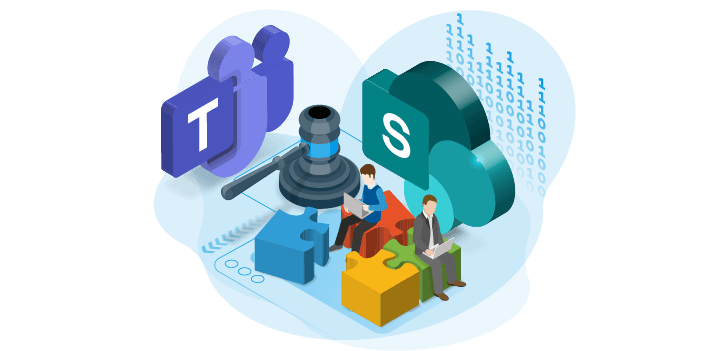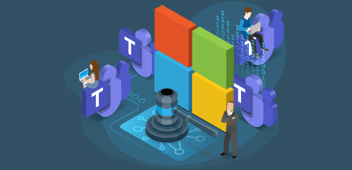For the last fifteen years, organizations have worked on transitioning from a classic non-reactive business to a pro-active and modern business empowered by cloud- based technology.
This transition was crucial to stay ahead of the competition and ensure long term sustainability and overall success. Microsoft 365 has proven to be the perfect example of a cloud technology supporting organization in their transition, varying from collaboration to business intelligence to AI.
Employees are the backbone of every organization. They need to be able to get their work done in an efficient and effective manner. This is only possible with a seamless collaboration experience. Microsoft 365 provides this experience with an integrated set of apps. The best example is Microsoft Teams. Teams is integrated with the vast majority of Microsoft 365 apps. Employees share content (SharePoint or OneDrive), work on tasks (Tasks by Planner and To Do) view appointments and meetings in their agenda (Exchange), work with line of business applications (Power Apps) and enter prompts to deliver meeting recaps (Copilot).
To successfully drive a seamless collaboration experience with Microsoft 365, I advise my customers to work on a governance strategy, adoption & change management approach, implement device & identity management and implement data security. For this article, I am focusing on my experience with defining and implementing a Microsoft 365 governance strategy.
Governance in the real world
Before we begin, it's crucial to remember that there's no definitive right or wrong when it comes to defining a governance strategy. It's your governance strategy, tailored to fit your organization.

While there are recommendations and proven practices available, ultimately, the effectiveness of the governance strategy hinges on its alignment with your organization and the needs of your employees. With that in mind, I aim to offer insights based on my real-world experience through sharing some tips.
Tip 1: Never too late to start
There is a prevalent misconception that once you've begun working with Microsoft 365, it's too late to establish a governance strategy. However, it's never too late to start. You can define a governance strategy based on your current requirements. Begin by gathering these requirements, then assess your existing configuration, processes, and procedures to understand their impact.
This assessment will inform you of a plan of action to implement the new requirements. For instance, you may need to establish a naming convention for existing teams and sites or adjust settings for current guest users. While changing configurations is relatively straightforward, the primary challenge lies in communication.
It's essential for your end-users to understand why these changes are occurring, how they will affect their work, and who they can contact for questions or support. Clear and effective communication is key to successful implementation.
Tip 2: No shame in provisioning
For years, Microsoft promoted a self-service strategy and messaging for collaboration within Microsoft 365, encouraging each employee to create their own teams or sites. However, the reality often diverges from this ideal. Despite promoting a self-service approach, some notable practices doesn’t empower end-users to take full advantage of Teams' collaboration capabilities. One notable example is the lack of updates to Microsoft Teams templates, which still lack support for essential features like naming conventions or a request, approval, and creation process.
Consequently, I recommend that every customer, particularly those with multiple collaboration templates, consider implementing a provisioning solution. Such a solution enables your organization to enforce governance requirements and achieve a smoother collaboration experience.
Tip 3: Finding the correct structure
The structure of Microsoft Teams appears straightforward at first glance, with teams and channels (general, private, and shared). However, this simplicity can pose challenges for customers with complex organizational structures.
Each part of the organizational structure has its own data and specific access requirements, complicating the task of defining collaboration templates and ensuring alignment with organizational divisions (such as sub-departments). To address this challenge, I have developed use-case scenarios within a demo environment for my customers.
These use-cases offer customers direct insights into the possibilities and potential limitations of their choices within Teams. By experiencing these scenarios firsthand, customers gain a deeper understanding of the impact of their decisions on their overall governance strategy.
Tip 4: Data Security & Lifecycle Management
Through extensive collaboration, both internally and externally, within Microsoft 365, a significant amount of content is generated, much of which contains sensitive information critical to your organization. Despite recognizing the importance of securing and managing the lifecycle of this content, many customers fail to prioritize it in their budget or roadmap.
This lack of prioritization poses a serious risk of data leaks, potentially leading to fines, reputational damage, loss of customer trust, and, in the worst-case scenario, organizational bankruptcy. I strongly advocate for discussing the risks associated with the absence of Data Security & Lifecycle Management during the formulation of your governance strategy.
The C-level executives are particularly sensitive to these risks, understanding the potential consequences. By highlighting these risks during governance discussions, you can secure additional budget and ensure a prominent place for Data Security & Lifecycle Management on the roadmap.
Tip 5: Change is around the corner
After finalizing your governance strategy, it's not time to rest. Instead, it's crucial to remain proactive and monitor changes within the technology sector, such as the introduction of Microsoft Copilot, as well as within your own organization. Change is inevitable and will undoubtedly impact your existing governance strategy.
Rather than resisting change, it's essential to embrace it and integrate it into your organizational identity. Regularly review your governance strategy with your steering committee, and be prepared to adapt and apply changes accordingly.
Most importantly, always communicate these changes with your end-users. Keeping them informed and involved ensures a smoother transition and maintains alignment with organizational goals.
Empower end-users to collaborate freely
Third-party governance solutions can help you define and execute your M365 governance strategy, and a great no-code option is Rencore Governance. It’s an all-round easy to use solution covering a breadth of M365 services and cloud collaboration pain points. Its intuitive provisioning capabilities include easy-to-request and implement content templates for SharePoint and Teams, allow organizations to strike a balance between collaboration and control, without compromising on either.
Furthermore, The Rencore Nova App, a teams integration for Rencore Governance, brings built-in governance best practices to the end-user. By this, departments outside IT can easily request content assets and access with prebuilt governance best practices. Business users are empowered to embrace their M365 collaboration experience better and IT can automate provisioning in line with their governance strategy, creating a self-service adoption approach that works.

Nova Workspaces are the M365 end-users’ playground for creating collaboration assets around Teams and SharePoint. You can select from a plethora of templates with built-in governance best practices that suit your collaboration needs. Customize relevant values including settings, security, channels, and related apps to make your projects bespoke. Once you are happy with the look and feel of your provisioning request, send it for approval.
Conclusion
During my years working with customers on their Microsoft 365 governance strategy, one thing remains constant: the importance of a proactive and adaptable approach. As my customers navigate the complexities of collaboration, data security, and lifecycle management within Microsoft 365, it becomes increasingly clear that governance is not a one-time task but an ongoing journey.
By recognizing the unique needs of your organization and leveraging proven strategies, you can establish robust governance frameworks that not only mitigate risks but also drive productivity and innovation. From defining governance strategies tailored to your organizational requirements to embracing change as an integral part of organizational identity, the path to effective Microsoft 365 governance is paved with continuous evaluation, adaptation, and communication.
Ultimately, success lies in your hands because you are willing to prioritize governance, engage stakeholders, and foster a culture of accountability and transparency. As we all embrace the opportunities and challenges presented by Microsoft 365, you should not forget the crucial role that governance plays in shaping the future of collaboration and security within your organization.
If you’d like to empower your end-users, I encourage you to explore the end-user enablement possibilities Rencore Governance has to offer.



